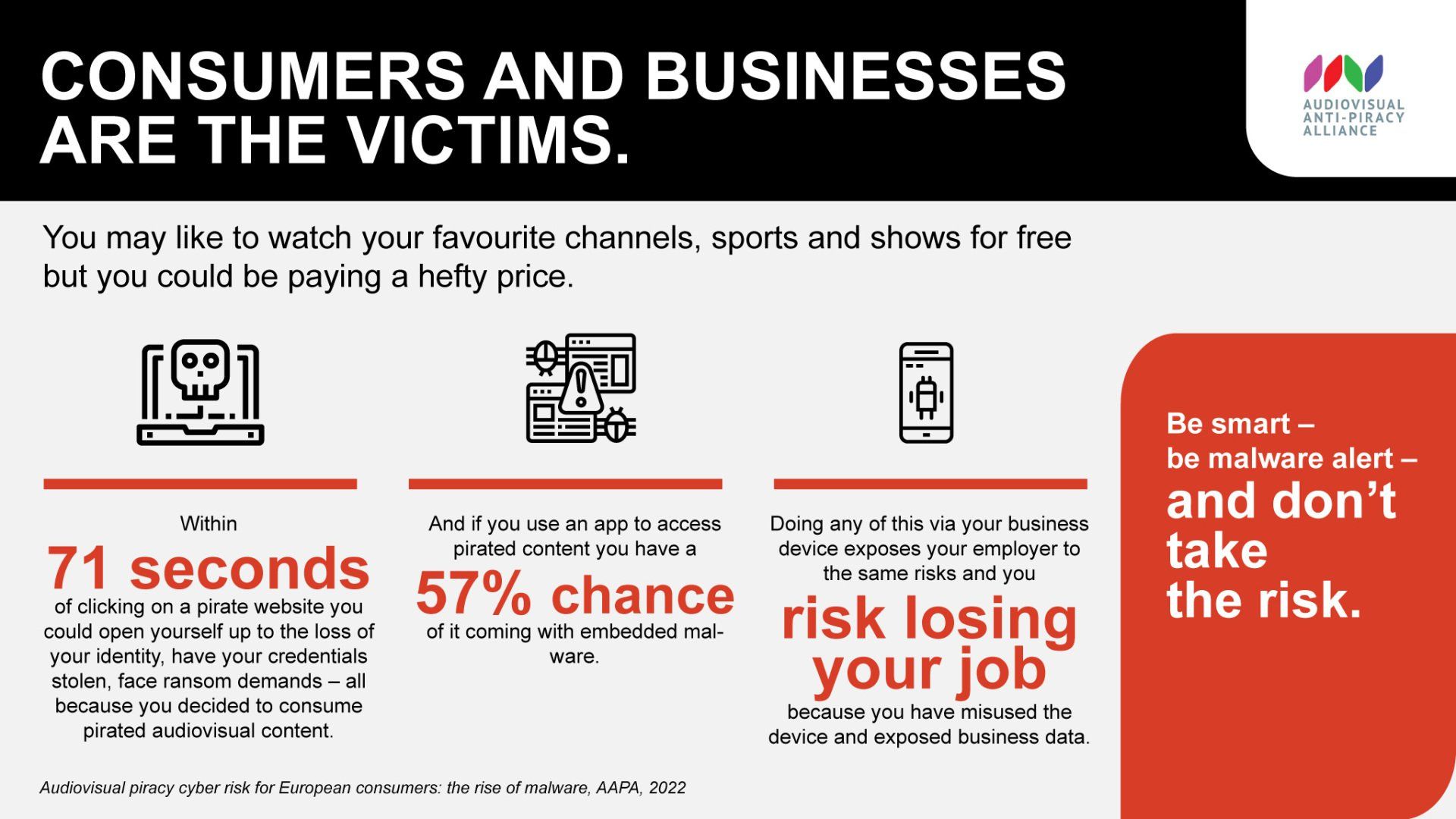STUDY ON MALWARE AND AUDIOVISUAL PIRACY HIGHLIGHTS SIGNIFICANT RISKS TO EUROPEAN CONSUMERS
AAPA
19 September 2022

Executive summary
Like consumers worldwide, European users of audiovisual piracy sites, apps, Illegal Streaming Devices, and Set-Top Boxes (STBs), often perceive that they can get “something for nothing” by using these services. Piracy is often perceived to be a victimless crime. The evidence presented in this study shows that the victim is the consumer, through the targeted delivery and installation of malicious software (malware) onto consumer devices, while they use audiovisual piracy sites, apps, ISDs and STBs. The impact of these malware infections can result in identity theft and fraud for the consumer, but also, lateral movement and further infection on any corporate network that they are connected to, such as remote working at home through a Virtual Private Network (VPN). Consumer behaviour is a direct threat to corporate networks, and the commercial consequences could be devastating, especially as more workers choose a flexible work pattern.
This study examined malware infection techniques across a broad range of actors targeting European consumers, finding that malware can be downloaded through malicious advertising, malicious popups, fake browser extension installations, browser notification hijacking, blocking notifications, adware, malicious software installation and banner ads. Furthermore, the study found an average 57% chance of an audiovisual piracy app being installed with embedded malware.
While European policymakers have focused on strengthening cybersecurity protections for many years, in practical terms – compared to Asian consumers in a similar study – there was no appreciable impact of these protections when visiting audiovisual piracy sites in relation to malware risk. The results of this study suggest that European regulatory frameworks need to focus on preventing consumer access to malicious audiovisual piracy sites, apps and STBs, through an expansion of regulatory site blocking, while acknowledging the risk of piracy-driven malware driving identity theft, in relation to the rollout of the European Digital Identity, and similar policy initiatives.
The full report can be downloaded from here

Online piracy has evolved into a structural threat to Europe’s cultural sovereignty, competitiveness and consumer safety. The Commission’s report recognises that existing voluntary and non-binding approaches to online piracy have not delivered the intended results. Piracy continues to grow in scale and sophistication, exploiting new technologies and digital distribution models. It undermines the foundations of Europe’s audiovisual ecosystem and weakens the Union’s ability to invest, innovate and compete globally. Online piracy contributes nothing to Europe’s cultural or economic fabric. Instead, it: • Diverts value away from legitimate creators, broadcasters, distributors while also depriving Member States of significant tax income. • Exposes consumers – including millions of EU citizens – to significant risks. • Connects to fraud, cyber-enabled crime and other illegal activities are well documented. Protecting Europe’s citizens and safeguarding the integrity of the Single Market requires decisive and coordinated EU-level action across its institutions. AAPA strongly welcomes the Commission’s renewed focus on the role of online intermediaries To be effective, the Digital Services Coordinators – supported by the Commission – must drive meaningful engagement and structural change across the intermediaries whose infrastructures are routinely leveraged by illegal operators. This involves not only hosting providers but also: • Digital infrastructure (CDNs, data centres, IP and domain registries, hardware providers) • Platforms and services (social media platforms, streaming services, e-commerce platforms) • Monetisation and reach enablers (payment services, online advertising networks) Clear expectations, transparency obligations and proactive measures are essential. Experience shows that where intermediaries engage constructively, significant progress follows. With many of these actors established within the EU, Commission’s leadership – supported by Parliament and the Council – is indispensable. AAPA also welcomes the Commission’s recognition of the growing use of dynamic blocking injunctions across Member States National authorities have taken important steps to safeguard cultural and creative sectors – through judicially supervised cooperation with residential ISPs, which has delivered: • Effective protection for live content • Reductions in the visibility and accessibility of illegal streams Fragmentation however limits impact. Only a coherent, EU-wide approach anchored in full chain engagement can deliver consistency, predictability and genuine deterrent effect. This is a natural area for EU leadership, completing work already underway in Member States. The Commission should therefore play a leading role in promoting a European framework for piracy blocking and coordinated action across the value chain. AAPA is ready to work with the Commission, Parliament and Council AAPA can support the institutions in shaping meaningful legislative solutions that reinforces Europe’s audiovisual sector and secure a resilient, competitive and culturally rich digital future for all Europeans.

Alicante, Spain – 30 April 2025 – The Audiovisual Anti-Piracy Alliance (AAPA) is urging policymakers to take decisive action against online piracy of live events following a key industry meeting hosted by the European Union Intellectual Property Office (EUIPO). This gathering brought together leaders from the European Commission, Member States, rights organizations, media companies, and tech platforms to assess the impact of the Commission’s Recommendation on combating online piracy , issued on 4 May 2023. Despite ongoing industry efforts, findings from the most recent second Grant Thornton study (March 2025) reveal: Little to no reduction in piracy levels since May 2023 No meaningful action from online intermediaries to curb piracy The Digital Services Act remains underdeveloped in addressing live content piracy Critically, Internet Service Providers (ISPs) and technical intermediaries have not participated in data collection, their silence serving as an indicator of the Recommendation’s limited impact. The Urgent Call for Legislation AAPA and industry stakeholders insist that voluntary measures are failing. To protect content creators and broadcasters an concrete update of legislation is mandatory, potentially through an extension of the DSA, including: A precise definition of “expeditious” action for live event protection A clear and enforceable Know Your Business Customer (KYBC) provision Broad inclusion of all relevant intermediaries Oliver Pribramsky, co-President of AAPA , Head of IP & Content Protection and Committees, DFL Deutsche Fußball Liga GmbH stated: "We welcome the discussion, but talk is not enough. Without concrete regulation, rightholders will continue to hemorrhage resources, limiting their ability to reinvest in valuable content. The time to act is now. Thank you to our esteemed colleagues from 2 CANAL + and Premier League, both members of our association, for representing the live rightholders’ point of view during the debate" AAPA looks forward to contributing to the recently opened Call for Evidence on Piracy of Live Content to plea once again that the fight against piracy demands urgent legislative support—industry efforts alone are not enough. For more information, contact Miruna Herovanu , Executive Director AAPA

The Audiovisual Anti-Piracy Alliance (AAPA) announces significant changes within its leadership team following recent elections. Stepping into the role of Co-President is Cameron Andrews, Legal Director for Anti-Piracy at beIN MEDIA GROUP - a leading independent global media group and one of the foremost sports & entertainment networks in the world – which distributes and produces entertainment, live sport and major international events across 5 continents, 40 countries and in 9 different languages spanning Europe, North America, Asia, Australasia and the Middle East & North Africa (MENA). Mr. Andrews brings a wealth of expertise and a passionate commitment to protecting audiovisual content. His leadership is anticipated to bolster the alliance’s efforts in facing evolving piracy challenges on a global scale. The elections also reaffirmed the appointment of Oliver Pribramsky, Head of IP & Content Protection and Committees at DFL, as Co-President for another mandate. Mr. Pribramsky’s continued service represents a steadfast dedication to safeguarding audiovisual rights and advancing collaborative anti-piracy strategies across the industry. Mark Mulready, Vice President - Cyber Services at Irdeto BV, has decided not to seek re-election for a fifth term as Co-President of AAPA, after 8 years of dedicated service and remarkable contributions to the alliance’s mission. He will continue to support AAPA’s mission as the Irdeto Board member. The alliance extends its deepest gratitude to Mr. Mulready for his unwavering commitment to combating audiovisual piracy, fostering industry collaboration, and championing innovation in anti-piracy measures. His leadership has been instrumental in driving the alliance’s success and advancing its objectives The AAPA remains resolute in its mission to protect intellectual property and support its members in combating piracy, ensuring a robust and secure future for the audiovisual sector. For more information contact Miruna Herovanu , Executive Director, AAPA

In the ongoing evaluation of the geo-blocking regulation, AAPA emphasises in its contribution the vital role geo-blocking measures play in protecting audiovisual services. Maintaining geo-blocking is essential for safeguarding intellectual property and supporting exclusive agreements, which are crucial for our industry’s financial model. Geo-blocking not only preserves cultural diversity but also protects jobs in the creative sector. It ensures that local audiences have access to tailored content while allowing for fair competition among broadcasters. Abolishing or restricting geo-blocking poses significant risks, including potential revenue losses that could threaten thousands of cinemas and millions of jobs across Europe. To ensure a vibrant cultural landscape and protect the interests of consumers, it is imperative to maintain geo-blocking for audiovisual content. Let's keep our creative industries strong!

On Tuesday 4th March, I had the privilege of moderating a pivotal event organised by the Live Content Coalition on behalf of the Audiovisual Anti-Piracy Alliance (AAPA). The event brought together key stakeholders from Europe's live content industry—including sports, music, and broadcasting. Our shared mission: to tackle the pressing issue of online piracy of live content with all its specificities. We kicked off the event with insightful welcome remarks from Bogdan Andrzej Zdrojewski, MEP and Vice-Chair of the Culture and Education Committee, setting the tone for our discussion, underlining once more that the European Parliament cares about the protection of live content. Sabina Tsakova from the European Commission also provided essential context about the institutional framework surrounding the protection of live content, the Recommendation against piracy of sports and other live content and next steps. Throughout the event, we explored what piracy looks like for rightholders in 2025 through Euan Fordyce’s presentation, shedding light on the evolving landscape. Mabel Au then shared compelling statistics, painting a clear picture of the (non)impact of the Recommendation between 2023 and 2025. In our panel discussion, we delved deep into the societal and economic implications of piracy with experts like Mark Lichtenhein, Simon Minkowski, and Johannes Studinger. Their perspectives highlighted the urgent need for effective legislation tailored to protect live content rights. Key takeaways from our discussion included: 1. The Importance of Legislation: Mark emphasized the necessity for ideal legislation to combat piracy, envisioning a framework that clarifies the term "expeditious" in the context of live content once and for all. 2. Understanding the Global Landscape: Simon provided insights into Canal+'s international strategy, addressing challenges faced in territories lacking effective legislative protection. 3. Impact on the AV Sector: Johannes discussed the post-COVID challenges for employees in the audiovisual sector and the pressing need for action to safeguard jobs and industry sustainability. 4. Broader Ecosystem Effects: We recognized that piracy affects not just broadcasters and rights holders, but the entire sports and cultural ecosystem, underscoring the necessity of a collaborative approach with our respective value chain. As we wrapped up the evening with a cocktail reception, it was clear that while challenges remain, our collective commitment to fighting piracy is stronger than ever. Together, we can pave the way for a more secure future for live content. Thank you to all the participants for their invaluable contributions! Let's continue to engage and advocate for change.

The Audiovisual Anti-Piracy Alliance met in London on February 25-26th to exchange on the latest developments in the piracy environment. We had the opportunity of having a very special guest, our friend, Davide Centonze, who presented his perspective on the specifics of the threats and the difficulties in tackling the very lucrative work of pirates that steal our members’ legitimate content. A big thanks to Davide! We also had all our questions answered on the Italian Piracy Shield and the deployment of AI in identifying illegal activities online. Thank you Marta Giannini for being amazing as always!

Date, Brussels, Belgium The Audiovisual Anti-Piracy Alliance (AAPA) is proud to announce the recipients of its annual awards, celebrating exceptional contributions by law enforcement agencies in combatting online piracy and protecting intellectual property in the audiovisual sector. This year’s honorees have demonstrated exemplary efforts in the investigation, enforcement, and dismantling of illegal content distribution networks that undermine the creative industries. The AAPA Annual Awards recognize agencies whose proactive strategies and collaborative actions have significantly advanced copyright enforcement online. These awards reflect the growing importance of international cooperation in addressing the evolving and sophisticated tactics used by piracy networks. Oliver Pribramsky, Co-President of AAPA , praised the recipients of the awards, saying: "We are honoured to recognise the outstanding work of these administrative and law enforcement agencies. Online piracy remains one of the most significant challenges facing the audiovisual industry, costing billions in lost revenue each year and threatening jobs across the sector. The dedication and innovation displayed by our award winners not only protect the industry but also reinforce the critical role that law enforcement plays in safeguarding intellectual property in the digital age." Award Recipients This year’s AAPA Awards for Excellence in Copyright Enforcement are presented to: 1. Lifetime achievement Award for Sheila Cassells: On behalf of all AAPA members and stakeholders from all spectrums of the industry, we would like to thank Sheila for her loyalty and friendship over the last 14 years where she transformed AAPA into the organisation it is today and honour her remarkable achievements and lifelong dedication to the fight against audiovisual piracy with this Lifetime Achievement Award.

The Audiovisual Anti-Piracy Alliance (AAPA) has supported the Catania Public Prosecutor’s Office, the Croatian State Attorney Office for Suppression of Corruption and Organised Crime and law enforcement agencies in Italy, Switzerland, Sweden, Croatia and England in dismantling the world’s largest transnational criminal organisation alleged to be serving pirated audiovisual content to over 22 million users, and generating over 250 million euros in illegal revenue per month. The operation, conducted yesterday, was coordinated by Europol and Eurojust and involved over 270 officers from the Polizia Postale carrying out 89 property searches in 15 Italian regions. An additional 14 searches were conducted by law enforcement agencies abroad, including five addresses in England, and further searches and seizures in the Netherlands, Sweden, Switzerland, Romania, France, Bulgaria, Germany and Croatia. 11 people were arrested by the Cybercrime Division of the Croatian Police. During yesterday's searches, cryptocurrencies in excess of EUR 1,650,000 and cash in excess of EUR 40,000 were seized as alleged proceeds of the offences committed. These immediately seized proceeds represent only a fraction of an illegal business that is alleged to yield approximately EUR 3 billion per annum. Digital piracy harms the entertainment and creative industries across the continent and is often run by sophisticated criminal networks that may use their profits to fund other serious forms of criminal activity. At the same time, illegal streams can expose the end user to the risks of data theft, fraud and malware. Mark Mulready, Co-president of AAPA, said: “We applaud the efforts of the Catania Public Prosecutor’s Office, the Croatian State Attorney Office for Suppression of Corruption and Organised Crime, Europol, Eurojust, and all of the law enforcement agencies involved in these operations. The scale of these multi-jurisdictional law enforcement actions highlights the considerable challenge our industry faces when dealing with such sophisticated international pirate networks. We are proud to have collaborated with our law enforcement partners to provide technical training and in-field support to assist them in successfully tackling the world’s largest pirate network. We are very grateful to the AAPA members who supported this action day, including Premier League, Sky Group, Nagravision, Deutsche Fußball Liga (DFL), beIN Sports, United Media, Friend MTS and Irdeto. We will continue to closely collaborate with law enforcement agencies in Europe and beyond to enable them to successfully identify, investigate and prosecute large-scale cross-border pirate networks.” ---------- AAPA contact: Mark Mulready +31651246415 Co-President AAPA Miranda Rock +44 7957 391 498 Rocket Launch for AAPA

The Audiovisual Anti-Piracy Alliance (AAPA) publishes its first Manifesto, linked here . The document aims to recognise past efforts of EU legislators when it comes to content protection and the fight against copyright infringement, whilst admitting that more can and should be done to address this growing issue. Miruna Herovanu, Executive Director of AAPA said : " After years of laying the groundwork to combat online piracy it’s time for EU policymakers and beyond to fully acknowledge that decisive, targeted measures are needed at the European level. The rise of digital theft demands action. We call for strong political resolve to end the theft of our members' content. We're ready to support every stakeholder—law enforcement, policymakers, and industry representatives—to dismantle criminal networks and protect European consumers from harm."


